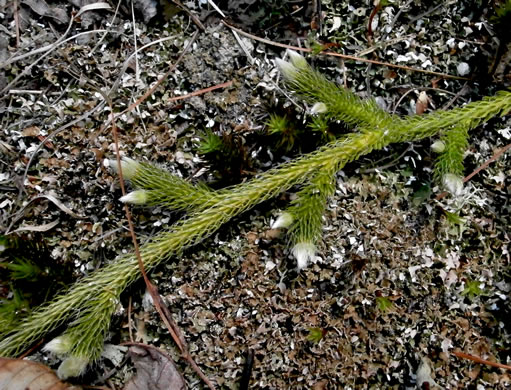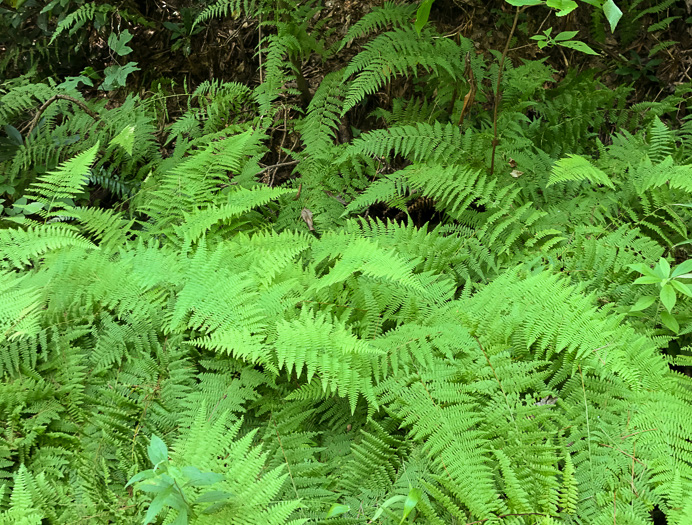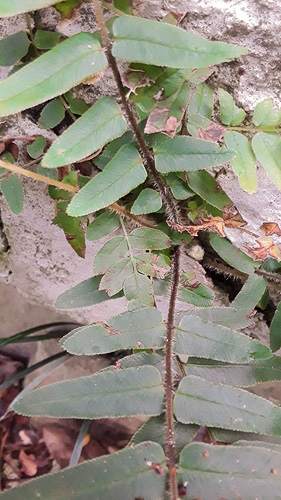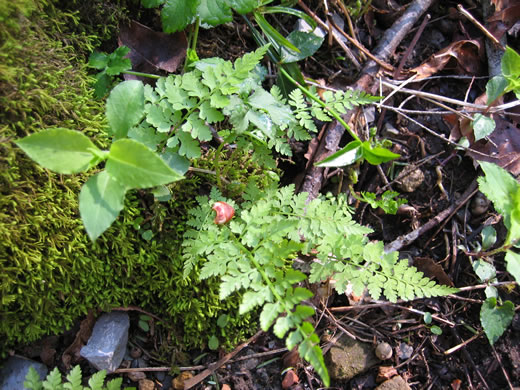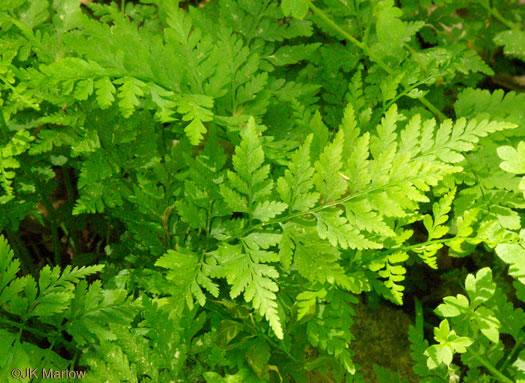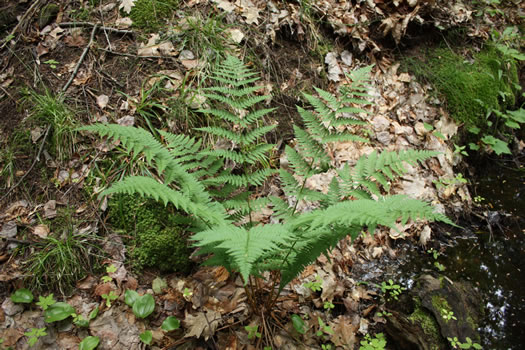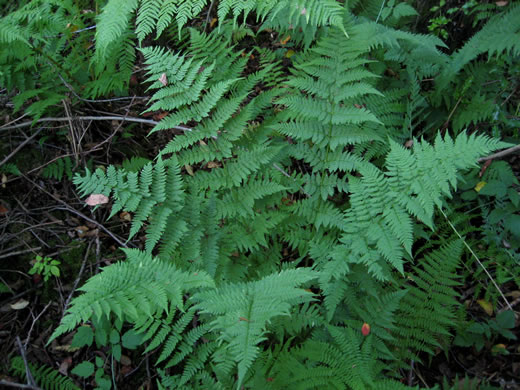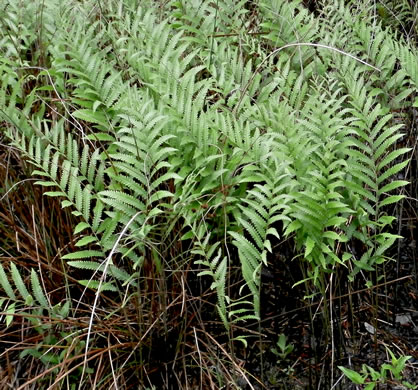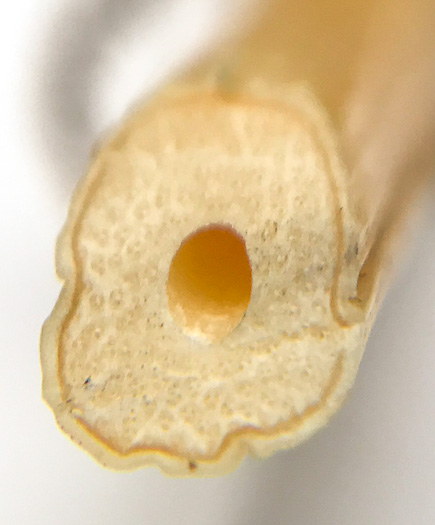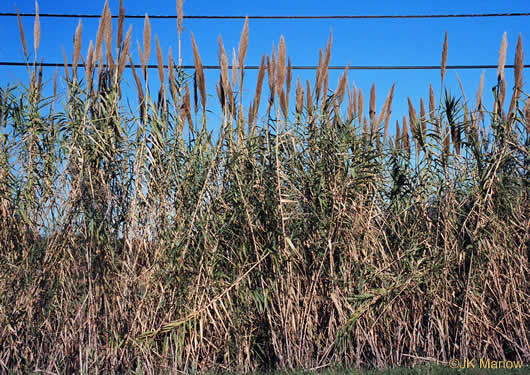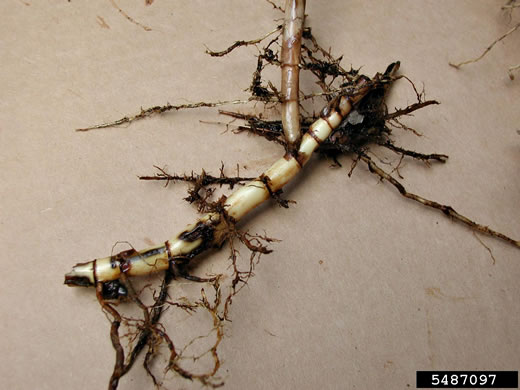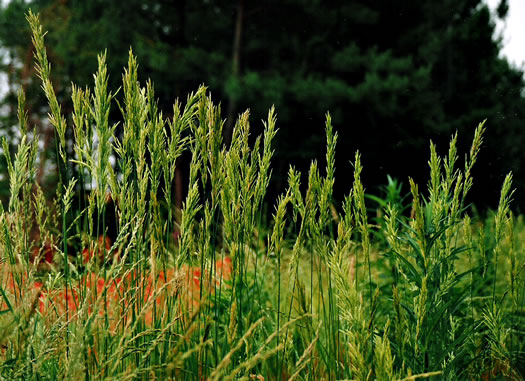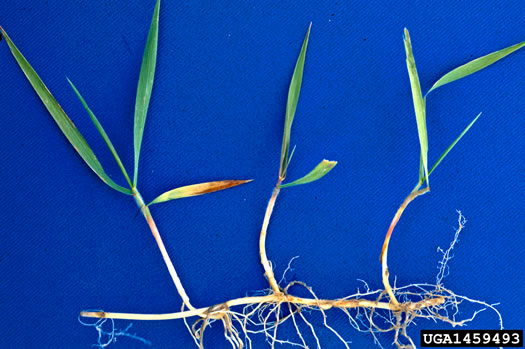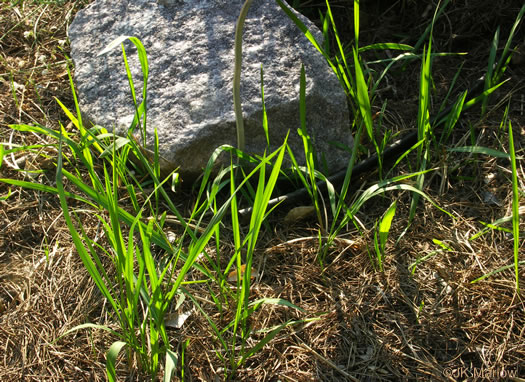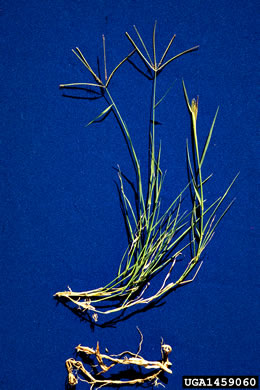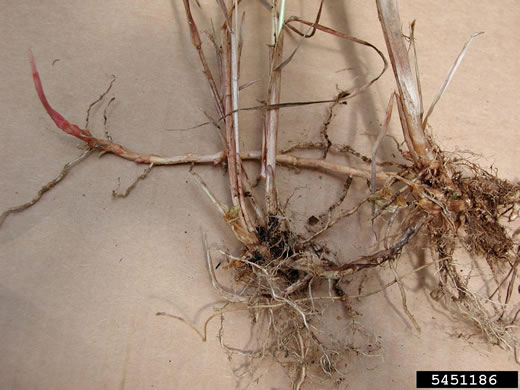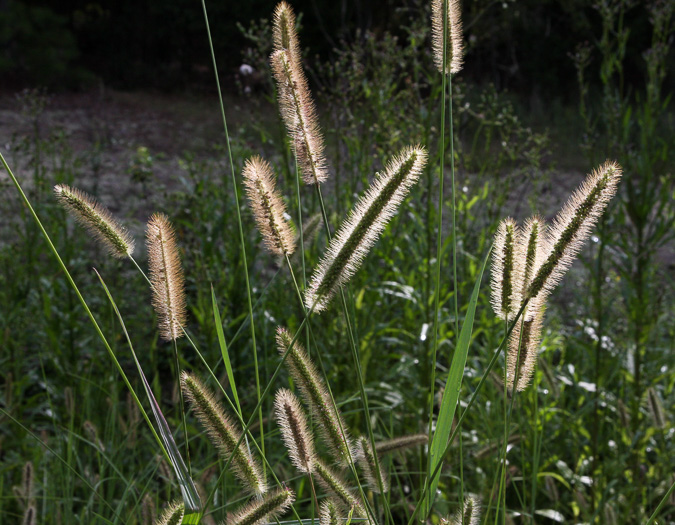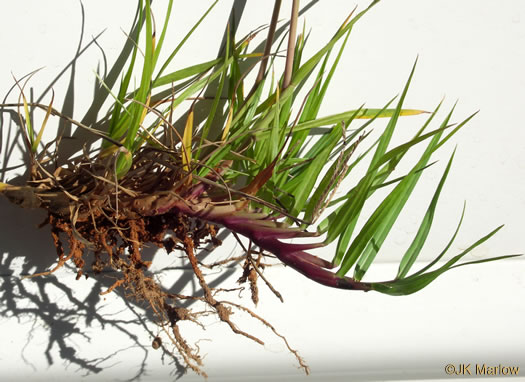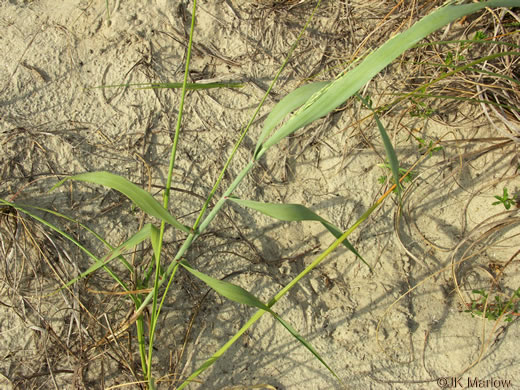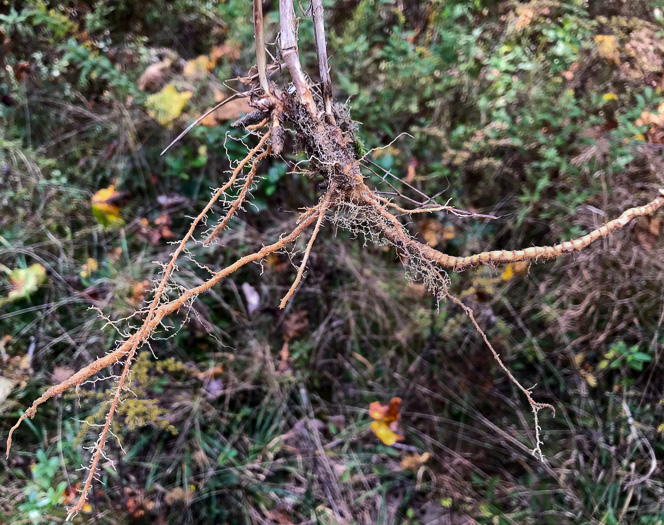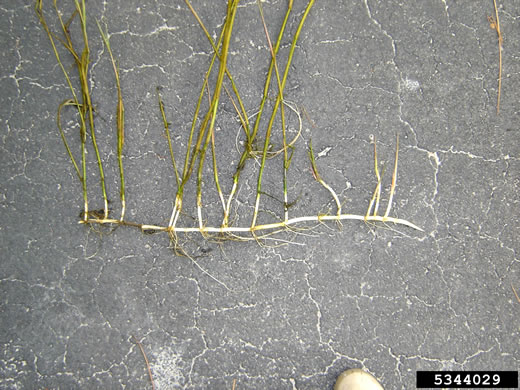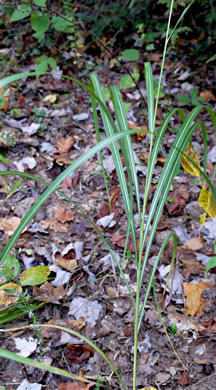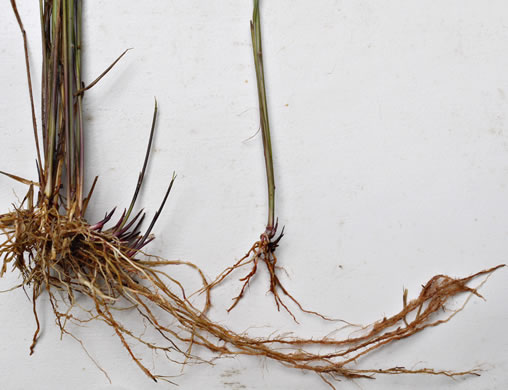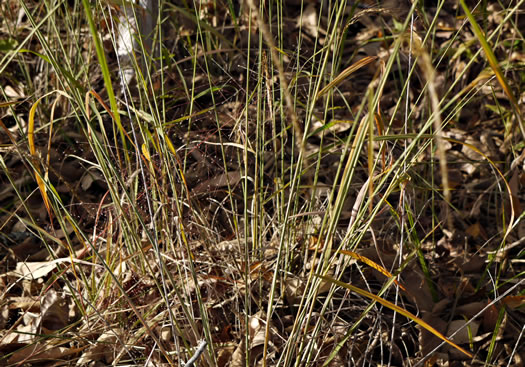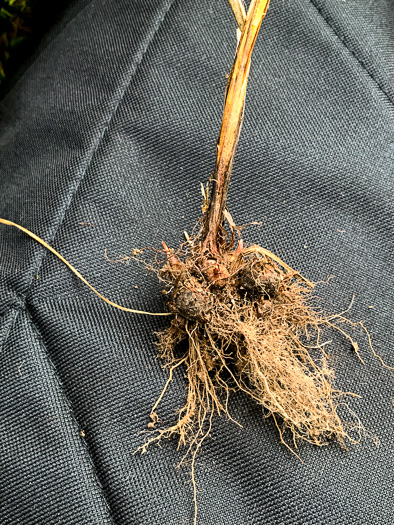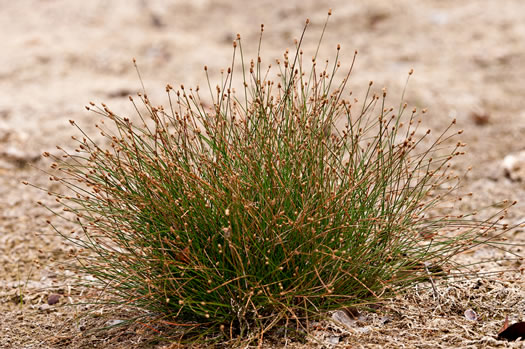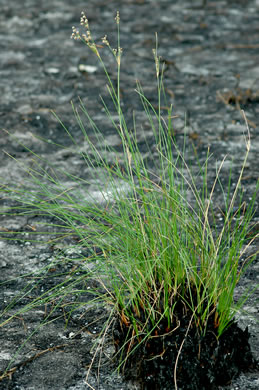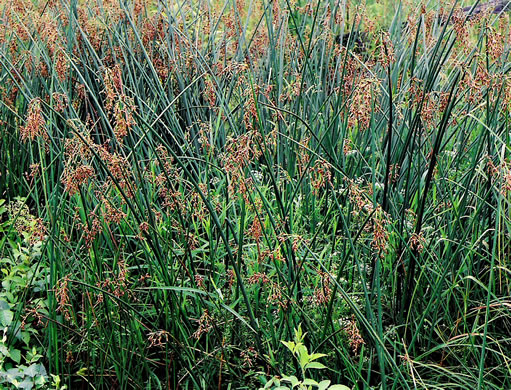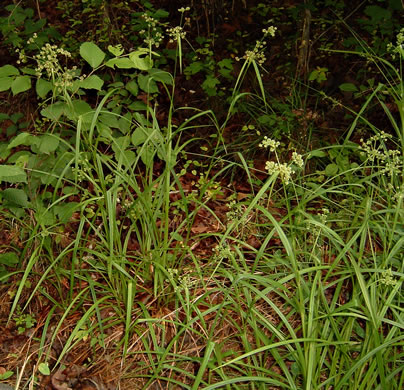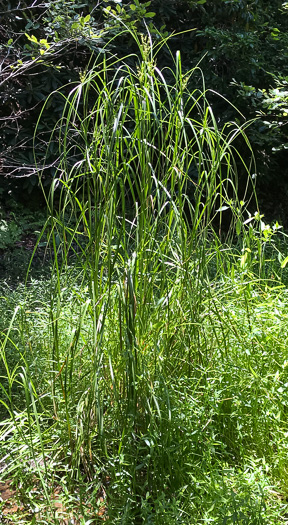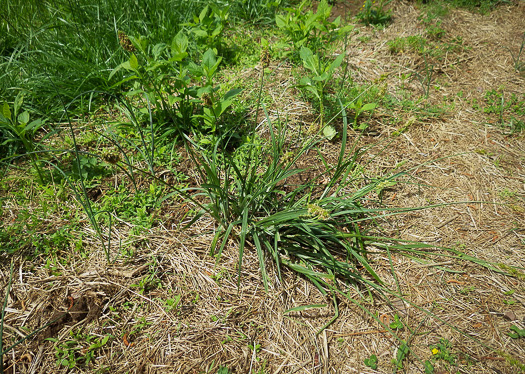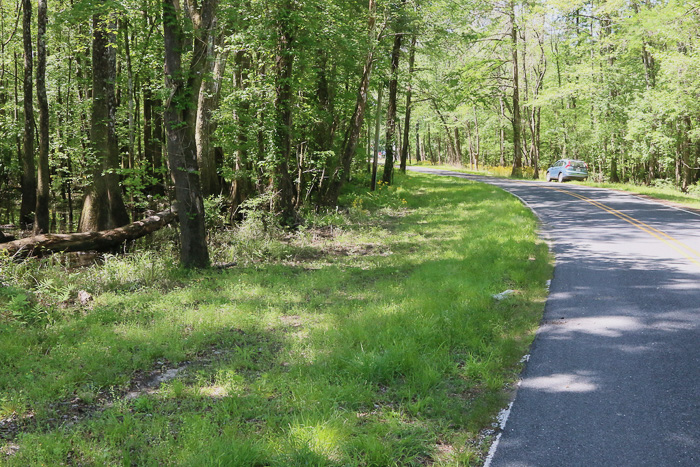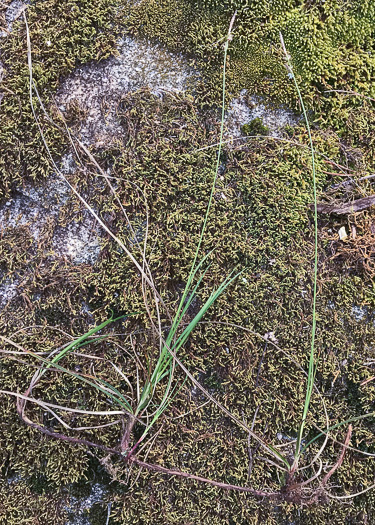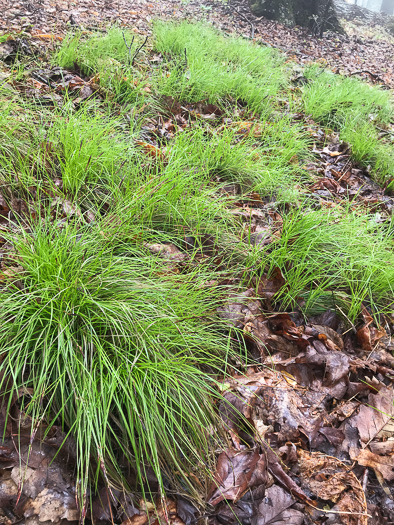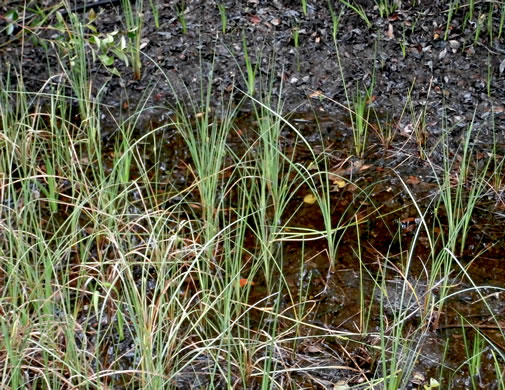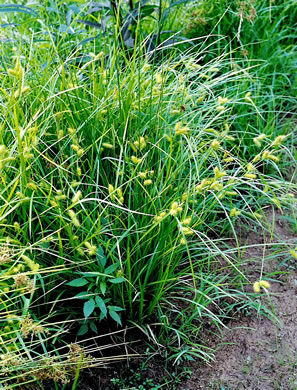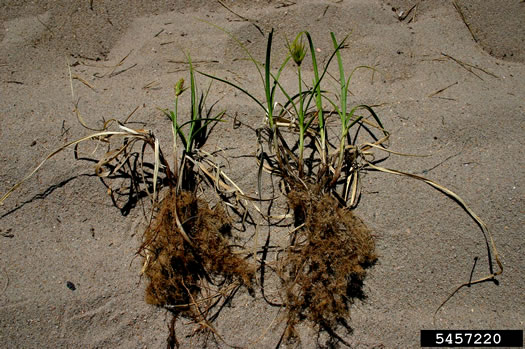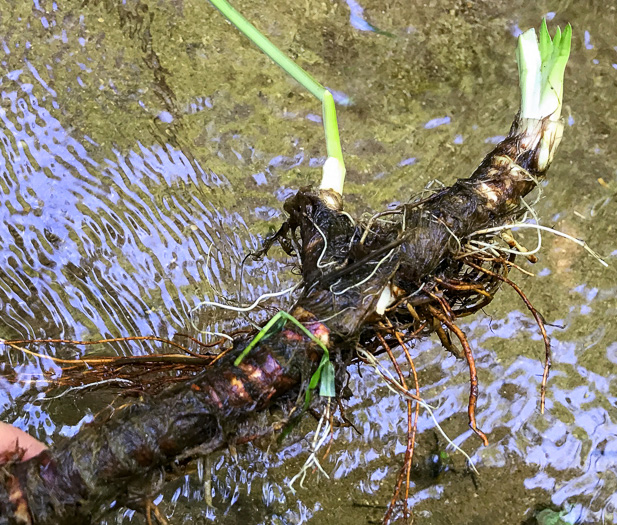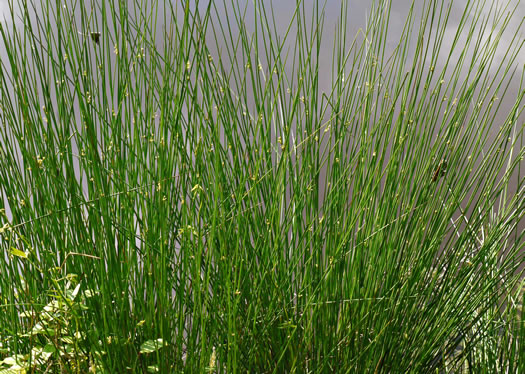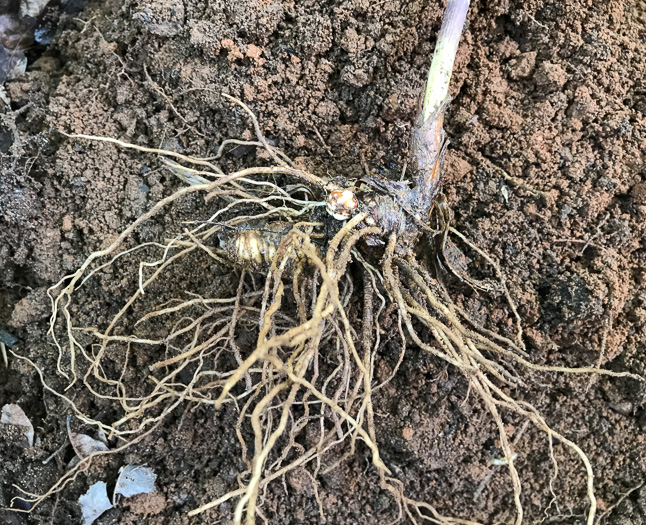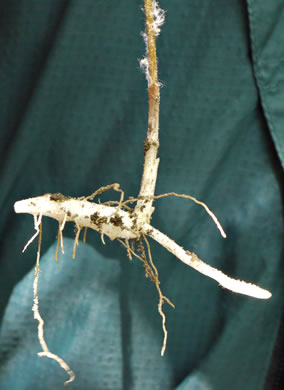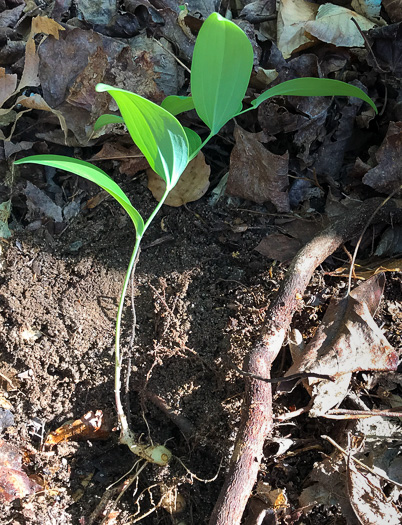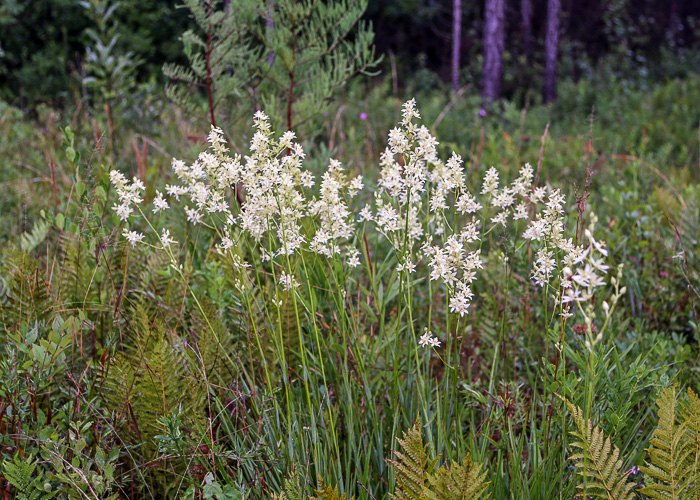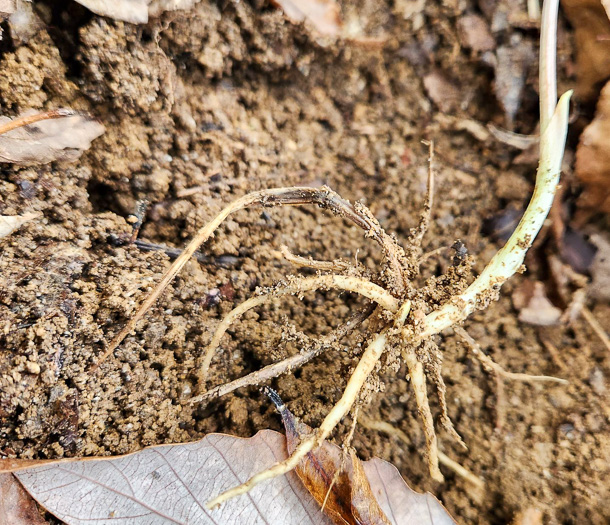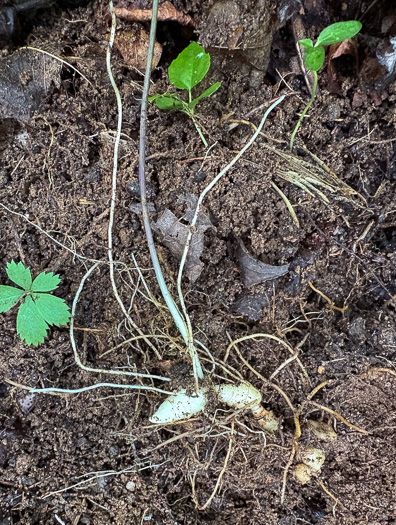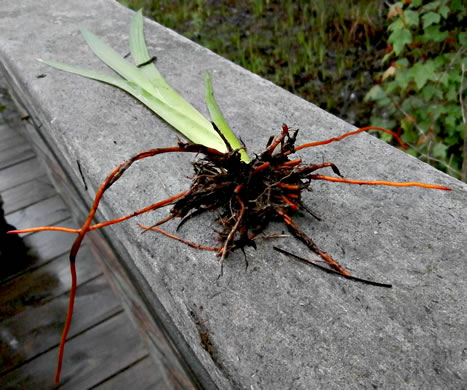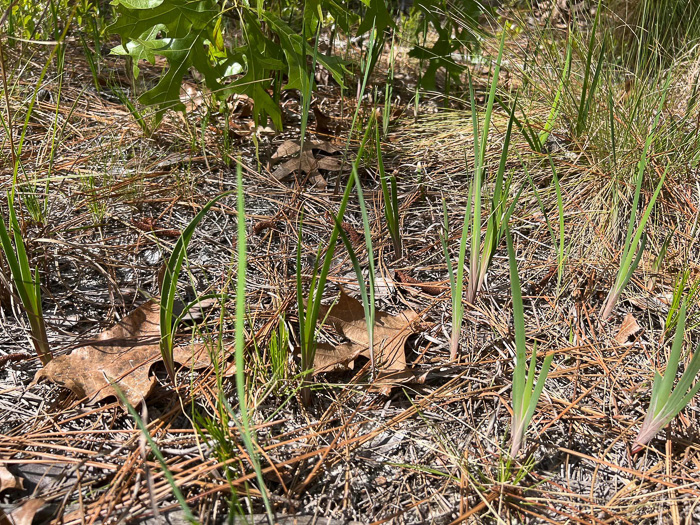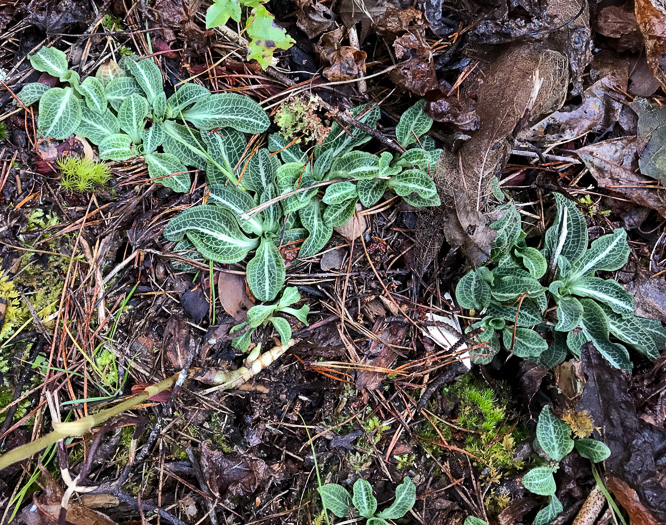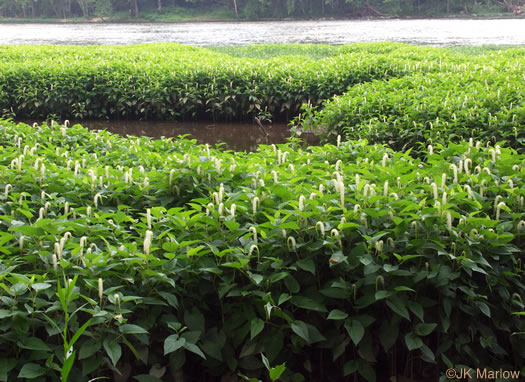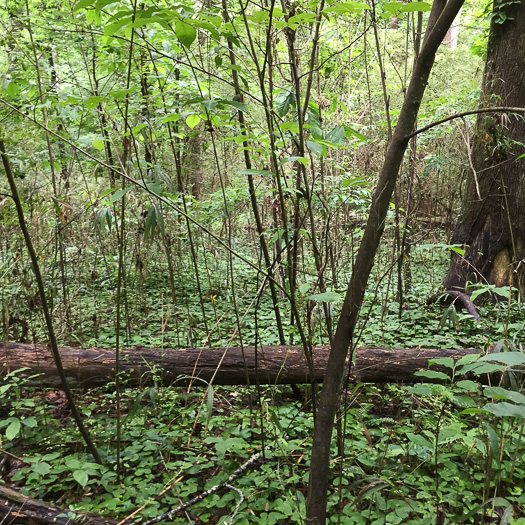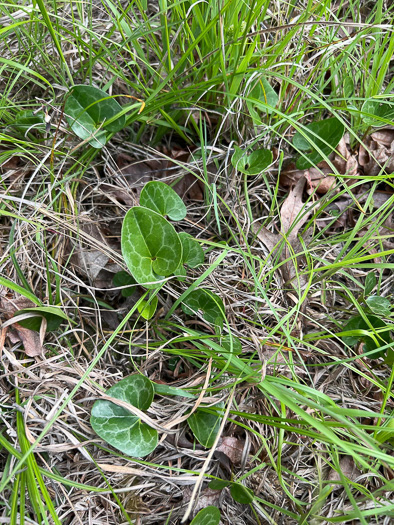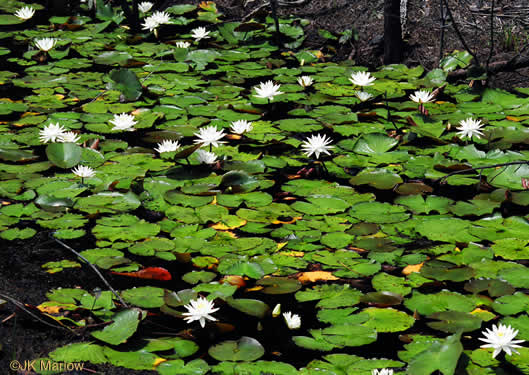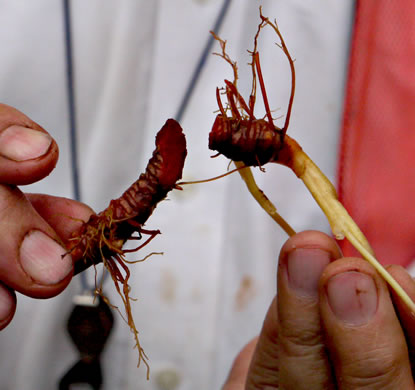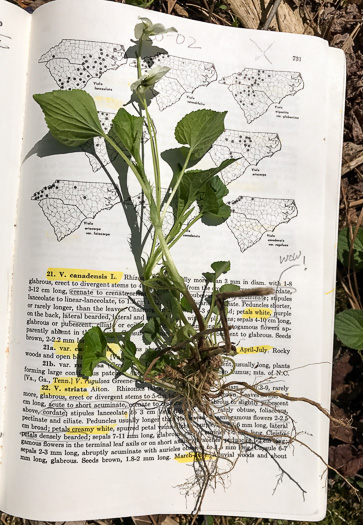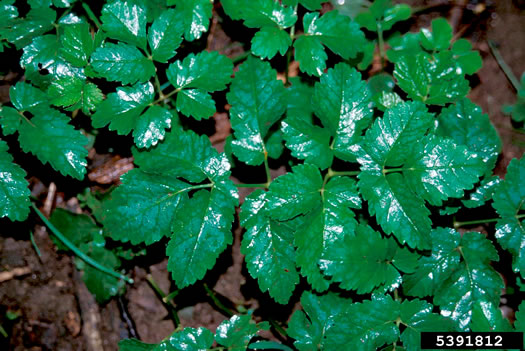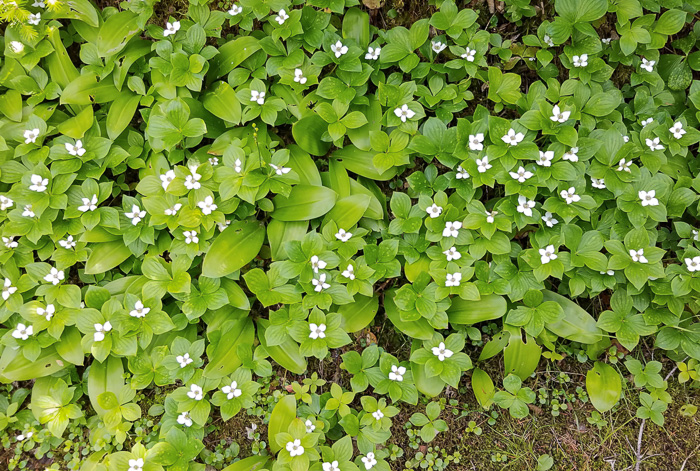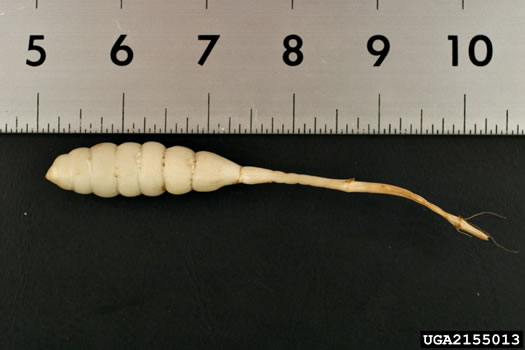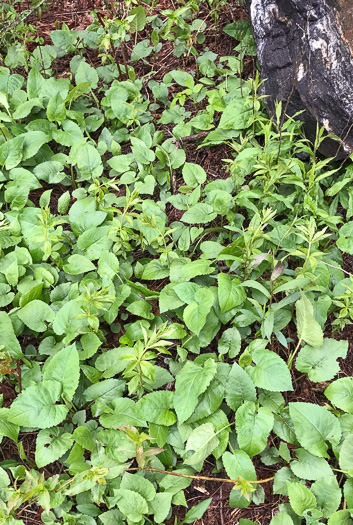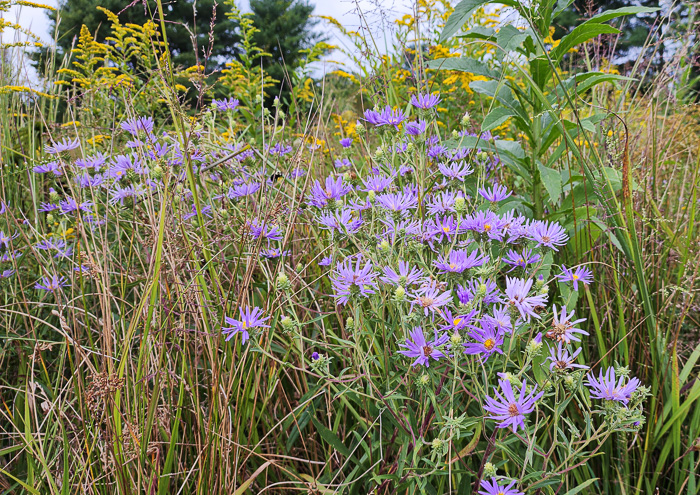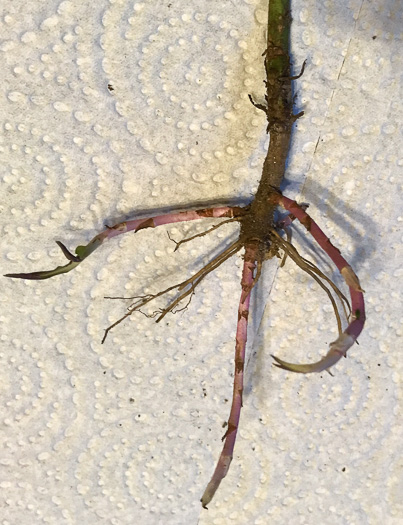Your search found 67 image(s) illustrating the term "rhizome." For a written explanation, click on "rhizome" in the Glossary.
PAGE 1 PAGE 2
To see larger pictures, click or hover over the thumbnails.
To go to the plant's detail page, click its name.
 Staghorn Clubmoss,
Lycopodium clavatum
Staghorn Clubmoss,
Lycopodium clavatum
Rhizome is above ground, with leaves like those of the upright stems, per Ferns of the Smokies (Evans, 2005).
 Hay-scented Fern,
Sitobolium punctilobulum
Hay-scented Fern,
Sitobolium punctilobulum
Fronds on long rhizomes, forming vigorous colonies in open disturbed areas, per Peterson Field Guide to Ferns of Northeastern and Central North America.
 Ladder Brake,
Pteris vittata
Ladder Brake,
Pteris vittata
Frond bases are brown and covered with the same hair-like scales as rhizomes, per New Invaders of the Southeast (Rawlins et al., 2018).
 Lowland Bladder Fern,
Cystopteris protrusa
Lowland Bladder Fern,
Cystopteris protrusa
Long-creeping rhizome extends forward past emerging fronds (thus protrusa), per Peterson Field Guide to Ferns of Northeastern and Central North America.
 Lowland Bladder Fern,
Cystopteris protrusa
Lowland Bladder Fern,
Cystopteris protrusa
Gently explore the soil below outermost emergent fronds to feel rhizome tip, per Peterson Field Guide to Ferns of Northeastern and Central North America.
 Evergreen Woodfern,
Dryopteris intermedia
Evergreen Woodfern,
Dryopteris intermedia
Delicate fronds rise in upright circular clusters from a central rhizome, per Peterson Field Guide to Ferns of Northeastern and Central North America.
 Spinulose Woodfern,
Dryopteris carthusiana
Spinulose Woodfern,
Dryopteris carthusiana
Tends to form clumps, because of short-creeping rhizome, per Peterson Field Guide to Ferns of Northeastern and Central North America.
 Virginia Chain-fern,
Anchistea virginica
Virginia Chain-fern,
Anchistea virginica
Fronds upright, scattered along rhizomes and emerging individually, per Peterson Field Guide to Ferns of Northeastern and Central North America.
 Hill Cane,
Arundinaria appalachiana
Hill Cane,
Arundinaria appalachiana
Rhizomes sometimes hollow-centered, air canals sometimes present, per Morphological comparison of Arundinaria appalachiana, A. tecta, and A. gigantea by Jimmy K. Triplett.
 Giant Reed,
Arundo donax
Giant Reed,
Arundo donax
Seeds apparently sterile. Reproduction is from fragments of stems & rhizomes, per Invasive Plants, Weeds of the Global Garden (Randall & Marinelli, 1996).
 Common Reed,
Phragmites australis
Common Reed,
Phragmites australis
Culms erect, with stout creeping rhizomes and often also with stolons, per Manual of the Grasses of the United States (Hitchcock & Chase, 1950).
 Smooth Brome,
Bromus inermis
Smooth Brome,
Bromus inermis
Plants with creeping rhizomes, forming clonal colonies, per Weakley's Flora (2012).
 Quackgrass,
Elymus repens
Quackgrass,
Elymus repens
With yellowish creeping rhizomes, per Manual of the Grasses of the United States (Hitchcock & Chase, 1950).
 Cogongrass,
Imperata cylindrica
Cogongrass,
Imperata cylindrica
New plants arise from horizontal underground stems or "rhizomes", per Field Guide to the Identification of Cogongrass.
 Bermuda Grass,
Cynodon dactylon
Bermuda Grass,
Cynodon dactylon
Extensively creeping by scaly rhizomes or strong flat stolons, per Manual of the Grasses of the United States (Hitchcock & Chase, 1950).
 Reed Canarygrass,
Phalaris arundinacea
Reed Canarygrass,
Phalaris arundinacea
Scaly rhizomes, per Weakley's Flora (2012).
 Perennial Foxtail-grass,
Setaria parviflora
Perennial Foxtail-grass,
Setaria parviflora
Panicle 3-8(10)cm long; plant from knotty rhizomes, per Weakley's Flora (2015).
 Bahia-grass,
Paspalum notatum
Bahia-grass,
Paspalum notatum
Shallow, often exposed, reddish to purple-colored, rhizomes, per Weeds of Southern Turfgrasses (Murphy et al., 1992).
 Seaside Panicum,
Panicum amarum var. amarum
Seaside Panicum,
Panicum amarum var. amarum
Stems solitary or in clumps; plant glaucous, glabrous, w extensive rhizomes, per Wildflowers of the Eastern United States (Duncan & Duncan, 1999).
 Switchgrass,
Panicum virgatum var. virgatum
Switchgrass,
Panicum virgatum var. virgatum
Scaly creeping rhizomes, per Manual of the Grasses of the United States (Hitchcock & Chase, 1950).
 Torpedo Grass,
Panicum repens
Torpedo Grass,
Panicum repens
Pointed tips of its extensive rhizomes (reaching 18'+) give this its name, per Invasive Plants, Guide to Identification, Impacts and Control (Kaufman & Kaufman, 2007).
 Chinese Silvergrass,
Miscanthus sinensis
Chinese Silvergrass,
Miscanthus sinensis
Very small pieces of rhizome can propagate new clumps, per Invasive Plants, Guide to Identification, Impacts and Control (Kaufman & Kaufman, 2007).
 Yellow Indiangrass,
Sorghastrum nutans
Yellow Indiangrass,
Sorghastrum nutans
Culms 1-2.5m tall from short, scaly rhizomes, per Manual of the Grasses of the United States (Hitchcock & Chase, 1950).
 Elliot's Indiangrass,
Sorghastrum elliottii
Elliot's Indiangrass,
Sorghastrum elliottii
Culms more slender than S. nutans, without rhizomes, blades narrower, per Manual of the Grasses of the United States (Hitchcock & Chase, 1950).
 Many-flowered Flatsedge,
Cyperus lancastriensis
Many-flowered Flatsedge,
Cyperus lancastriensis
Short rhizomes scarcely visible between culm bases. Culms basally cormlike, per Flora of North America.
 Canada spikesedge,
Eleocharis geniculata
Canada spikesedge,
Eleocharis geniculata
Plants tufted, without creeping rhizomes, per Flora of North America.
 Marsh Fimbry,
Fimbristylis castanea
Marsh Fimbry,
Fimbristylis castanea
Plant cespitose, lacking rhizomes; lf bases leathery, dark brown, deeply set, per Weakley's Flora (2015).
 Softstem Bulrush,
Schoenoplectus tabernaemontani
Softstem Bulrush,
Schoenoplectus tabernaemontani
Forms dense colonies from horizontal rhizomes. Stems stout, 1-3cm at base, per Forest Plants of the Southeast and Their Wildlife Uses (Miller & Miller, 2005).
 Georgia Bulrush,
Scirpus georgianus
Georgia Bulrush,
Scirpus georgianus
Coarse tufted perennial from short, thick rhizomes. Blade tips 3-angled, per Vascular Flora of the Carolinas (Radford, Ahles, & Bell, 1968).
 Woolgrass Bulrush,
Scirpus cyperinus
Woolgrass Bulrush,
Scirpus cyperinus
Plants form dense clumps from short rhizomes and a mix of flowering and vegetative shoots, per www.minnesotawildflowers.info.
 Heavy Sedge,
Carex gravida
Heavy Sedge,
Carex gravida
Plants without conspicuous rhizomes, per Flora of North America.
 Low Woodland Sedge,
Carex socialis
Low Woodland Sedge,
Carex socialis
Culms arise scattered along creeping rhizomes [not in tight clumps], per Weakley's Flora (2020).
 Pennsylvania Sedge,
Carex pensylvanica
Pennsylvania Sedge,
Carex pensylvanica
Plants form loose clumps and create colonies from spreading rhizomes, per www.minnesotawildflowers.info.
 Appalachian Woodland Sedge,
Carex austrolucorum
Appalachian Woodland Sedge,
Carex austrolucorum
Plants with long rhizomes, forming clonal patches, per Weakley's Flora (2022).
 Walter’s Sedge,
Carex striata var. striata
Walter’s Sedge,
Carex striata var. striata
Forming large clonal colonies by rhizomes, per Weakley's Flora (2015).
 Sallow Sedge,
Carex lurida
Sallow Sedge,
Carex lurida
Plants densely to loosely cespitose; rhizomes short, no more than 10cm, per Flora of North America.
 Japanese Sand Sedge,
Carex kobomugi
Japanese Sand Sedge,
Carex kobomugi
Sand burial seems to stimulate growth of rhizomes, per Invasive Plants, Guide to Identification, Impacts and Control (Kaufman & Kaufman, 2007).
 European Sweetflag,
Acorus calamus
European Sweetflag,
Acorus calamus
Spreads vegetatively by shallow, branching, stout, knobby rhizomes w brown exterior/white interior, per www.illinoiswildflowers.info.
 Soft Rush,
Juncus effusus ssp. solutus
Soft Rush,
Juncus effusus ssp. solutus
Rhizomes short-branched, in distinct often large clumps. Culms erect, terete, per Flora of North America.
 Catesby's Trillium,
Trillium catesbyi
Catesby's Trillium,
Trillium catesbyi
Rhizome horizontal, 2-4cm long, 10-15mm in diameter, per Vascular Flora of the Carolinas (Radford, Ahles, & Bell, 1968).
 Indian Cucumber-root,
Medeola virginiana
Indian Cucumber-root,
Medeola virginiana
Tapered, white, tuberlike, horizontal rhizomes, 3-8 x 1cm, per Flora of North America.
 Smooth Solomon's Seal,
Polygonatum biflorum +
Smooth Solomon's Seal,
Polygonatum biflorum +
Rhizomes with knobby swellings run horizontally beneath the soil surface, per Wildflowers & Plant Communities of the Southern Appalachian Mountains and Piedmont (Spira, 2011).
 Large Death Camas,
Zigadenus glaberrimus
Large Death Camas,
Zigadenus glaberrimus
Solitary or forming small colonies via rhizomes, stems 50-80cm tall. Leaves pleated lengthwise, per Wildflowers of the Sandhills Region (Sorrie, 2011).
 Mountain Bellwort,
Uvularia puberula
Mountain Bellwort,
Uvularia puberula
Rhizome very short, with clustered, thickened roots, per Weakley's Flora (2024).
 Wild-oats,
Uvularia sessilifolia
Wild-oats,
Uvularia sessilifolia
Rhizome elongate, with scattered, fibrous roots, per Weakley's Flora (2025).
 Carolina Redroot,
Lachnanthes caroliniana
Carolina Redroot,
Lachnanthes caroliniana
Leaves distichous and bases overlapping (like Iris). Roots and rhizomes red, per Vascular Flora of the Carolinas (Radford, Ahles, & Bell, 1968).
 Coastal Plain Dwarf Iris,
Iris verna var. verna
Coastal Plain Dwarf Iris,
Iris verna var. verna
Leaf-bearing shoots spaced at intervals of (5-) 8-15cm along the rhizome, per Weakley's Flora (2023).
 Downy Rattlesnake-orchid,
Goodyera pubescens
Downy Rattlesnake-orchid,
Goodyera pubescens
Plants spread by underground stems (rhizomes) and may have multiple rosettes, per Wildflowers & Plant Communities of the Southern Appalachian Mountains and Piedmont (Spira, 2011).
 Lizard's-tail,
Saururus cernuus
Lizard's-tail,
Saururus cernuus
Perennial wetland herb that forms large colonies from underground rhizomes, per Atlantic Coastal Plain Wildflowers (Nelson, 2006).
 Reflexed Wild Ginger,
Asarum reflexum
Reflexed Wild Ginger,
Asarum reflexum
Plants spread both by seeds and by rhizomes, sometimes in dense carpets, per Wildflowers & Plant Communities of the Southern Appalachian Mountains and Piedmont (Spira, 2011).
 Lewis's Heartleaf,
Hexastylis lewisii
Lewis's Heartleaf,
Hexastylis lewisii
Leaves scattered along the length of the long-creeping rhizome, plants thus forming clonal mats, per Weakley's Flora (2023).
 Fragrant White Water-lily,
Nymphaea odorata ssp. odorata
Fragrant White Water-lily,
Nymphaea odorata ssp. odorata
Free-floating and anchored from a thick rhizome, per Wildflowers of the Carolina Lowcountry (Porcher, 1995).
 Bloodroot,
Sanguinaria canadensis
Bloodroot,
Sanguinaria canadensis
Thick rhizomes with bright orange-red juice, per Vascular Flora of the Carolinas (Radford, Ahles, & Bell, 1968).
 Pale Violet,
Viola striata
Pale Violet,
Viola striata
Rhizomes thick, more than 4mm in diameter, per Vascular Flora of the Carolinas (Radford, Ahles, & Bell, 1968).
 Goutweed,
Aegopodium podagraria
Goutweed,
Aegopodium podagraria
Leaves arising from the rhizomes typically outnumber flower-bearing stems, per USDA Forest Service Weed of the Week (Northeastern Area).
 Bunchberry,
Chamaepericlymenum canadense
Bunchberry,
Chamaepericlymenum canadense
Herb or dwarf shrub from a woody rhizome, to 2dm tall, per Weakley's Flora (2022).
 Florida Betony,
Stachys floridana
Florida Betony,
Stachys floridana
Slender rhizomes terminated by segmented tuberous structures to 1cm diameter, per Vascular Flora of the Carolinas (Radford, Ahles, & Bell, 1968).
 Bigleaf Aster,
Eurybia macrophylla
Bigleaf Aster,
Eurybia macrophylla
Rhizomes long, the plants forming extensive clonal colonies, per Weakley's Flora (2023).
 Low Showy Aster,
Eurybia spectabilis
Low Showy Aster,
Eurybia spectabilis
1-5 erect stems at the ends of long rhizomes, forming colonies, per Vascular Flora of the Carolinas (Radford, Ahles, & Bell, 1968).
 Bushy Aster,
Symphyotrichum dumosum var. coridifolium
Bushy Aster,
Symphyotrichum dumosum var. coridifolium
Mostly not strongly rhizomatous (sometimes with multiple stems from short-creeping rhizomes), per Weakley's Flora (2023).

